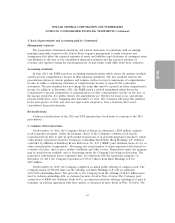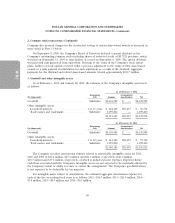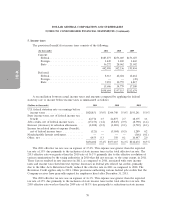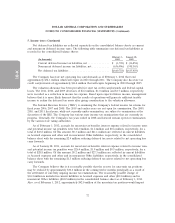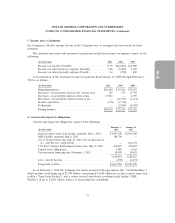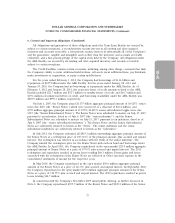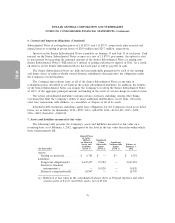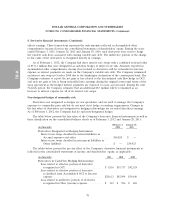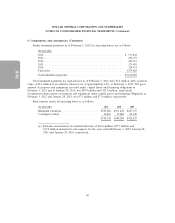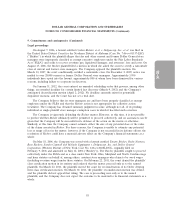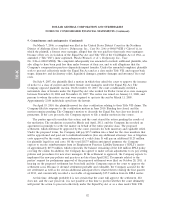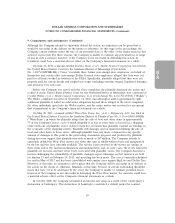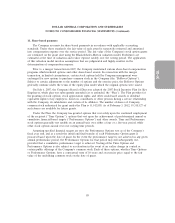Dollar General 2011 Annual Report Download - page 177
Download and view the complete annual report
Please find page 177 of the 2011 Dollar General annual report below. You can navigate through the pages in the report by either clicking on the pages listed below, or by using the keyword search tool below to find specific information within the annual report.
10-K
DOLLAR GENERAL CORPORATION AND SUBSIDIARIES
NOTES TO CONSOLIDATED FINANCIAL STATEMENTS (Continued)
7. Assets and liabilities measured at fair value (Continued)
(b) Reflected at book value in the consolidated balance sheet as Current portion of long-term
obligations of $590 and Long-term obligations of $2,617,891.
(c) Reflected at fair value in the consolidated balance sheet as Accrued expenses and other
current liabilities.
(d) Reflected at fair value in the consolidated balance sheet as Accrued expenses and other
current liabilities of $1,377 and non-current Other liabilities of $17,570.
The carrying amounts reflected in the consolidated balance sheets for cash, cash equivalents,
short-term investments, receivables and payables approximate their respective fair values. The Company
does not have any fair value measurements using significant unobservable inputs (Level 3) as of
February 3, 2012.
8. Derivative financial instruments
The Company enters into certain financial instrument positions, all of which are intended to be
used to reduce risk by hedging an underlying economic exposure.
Risk management objective of using derivatives
The Company is exposed to certain risks arising from both its business operations and economic
conditions. The Company principally manages its exposures to a wide variety of business and
operational risks through management of its core business activities. The Company manages economic
risks, including interest rate, liquidity, and credit risk, primarily by managing the amount, sources, and
duration of its debt funding and the use of derivative financial instruments. Specifically, the Company
enters into derivative financial instruments to manage exposures that arise from business activities that
result in the receipt or payment of future known and uncertain cash amounts, the value of which are
determined primarily by interest rates. The Company’s derivative financial instruments are used to
manage differences in the amount, timing, and duration of the Company’s known or expected cash
receipts and its known or expected cash payments principally related to the Company’s borrowings.
The Company is exposed to certain risks arising from uncertainties of future market values caused
by the fluctuation in the prices of commodities. From time to time the Company may enter into
derivative financial instruments to protect against future price changes related to these commodity
prices.
Cash flow hedges of interest rate risk
The Company’s objectives in using interest rate derivatives are to add stability to interest expense
and to manage its exposure to interest rate changes. To accomplish this objective, the Company
primarily uses interest rate swaps as part of its interest rate risk management strategy. Interest rate
swaps designated as cash flow hedges involve the receipt of variable-rate amounts from a counterparty
in exchange for the Company making fixed-rate payments over the life of the agreements without
exchange of the underlying notional amount.
The effective portion of changes in the fair value of derivatives designated and that qualify as cash
flow hedges is recorded in Accumulated other comprehensive income (loss) (also referred to as ‘‘OCI’’)
and is subsequently reclassified into earnings in the period that the hedged forecasted transaction
77


